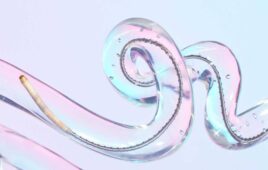Bedside insertion of a feeding tube may be a common procedure, but poor placement is associated with complications ranging from aspiration to infection, injury and even death.
To keep nurses up to date on the latest evidence-based practice, the American Association of Critical-Care Nurses (AACN) recently updated its AACN Practice Alert, Initial and Ongoing Verification of Feeding Tube Placement in Adults. The AACN Practice Alert applies to blind insertions and placements with an electromagnetic device.
This alert is the latest in a series of advisories issued by AACN to standardize practice and update nurses and other healthcare providers on new clinical advances and trends. All Practice Alerts are available on the AACN website, www.aacn.org/practicealerts and can be downloaded free of charge.
Known internationally for her feeding tube research, Norma Metheny, RN, Ph.D., FAAN, associate dean of research at Saint Louis University School of Nursing, developed this Practice Alert for AACN.
“Bedside insertion of a feeding tube takes place so frequently that it’s often considered an innocuous procedure, but it can cause serious and even fatal complications,” she said. “It’s important for nurses and other providers to stay up to date on evidence-based practice, especially for the most common procedures.
Based on the most current evidence, the expected practice during the insertion procedure is to use a combination of two or more of the following bedside methods to predict tube location:
- Observe for signs of respiratory distress
- Use capnography if available
- Measure pH of aspirate from tube if pH strips are available
- Observe visual characteristics of aspirate from the tube
These results can be used to determine when it is time to use radiography to confirm tube location and may be able to reduce the number of confirming radiographs to one.
Nurses should not use the auscultatory (air bolus) or water bubbling method (holding tube under water) to determine tube location.
Correct placement of a blindly inserted small-bore or large-bore tube should be confirmed with a radiograph that visualizes the entire course of the tube prior to its initial use for feedings or medication administration. This recommendation also applies to a tube inserted with assistance from an electronic tube placement (ETP) device and gastric decompression tubes that are later used for other purposes.
Once correct tube placement is confirmed, the exit site from the patient’s nose or mouth should be immediately marked and documented.
After feedings are started, tube location should be checked at four-hour intervals.
Supported by authoritative evidence, each AACN Practice Alert seeks to ensure excellence in practice along with promotion of a safe and humane work environment. Topics address both nursing and interprofessional activities of importance to patients in acute and critical care environments. Some alerts include additional resources for staff education and performance-improvement activities.
Additional alerts address aspiration, noninvasive blood pressure monitoring, dysrhythmia monitoring, pulmonary artery pressure monitoring, ST segment monitoring, family presence during CPR and invasive procedures and prevention of catheter-associated urinary tract infections.
About the American Association of Critical-Care Nurses
Founded in 1969 and based in Aliso Viejo, CA, the American Association of Critical-Care Nurses (AACN) is the largest specialty nursing organization in the world. AACN represents the interests of more than half a million acute and critical care nurses and includes more than 225 chapters worldwide. The organization’s vision is to create a healthcare system driven by the needs of patients and their families in which acute and critical care nurses make their optimal contribution.
American Association of Critical-Care Nurses, 101 Columbia, Aliso Viejo, CA 92656-4109;
Phone: 949-362-2000; www.aacn.org; facebook.com/aacnface; twitter.com/aacnme




